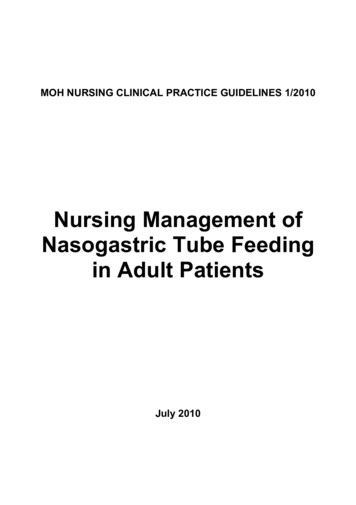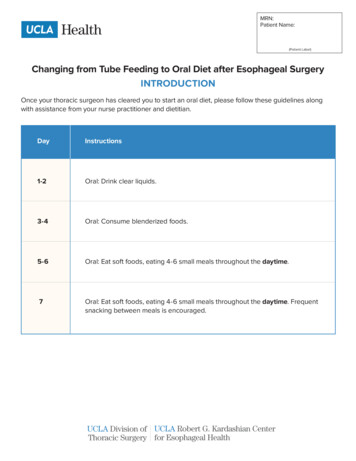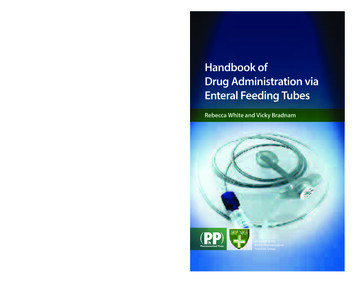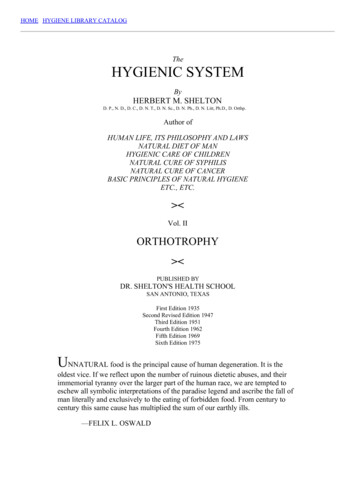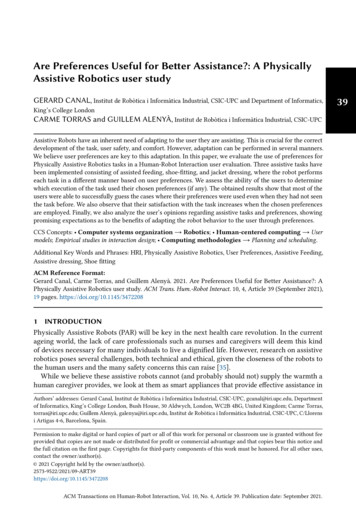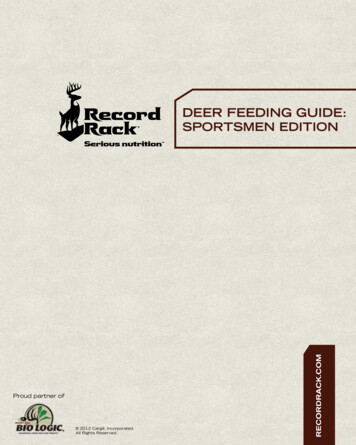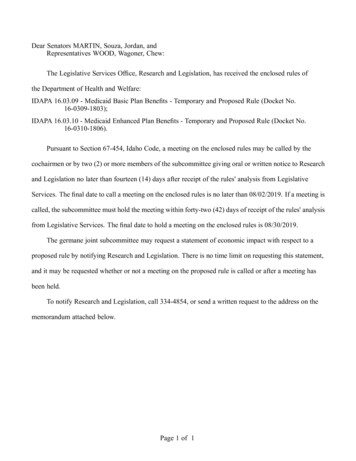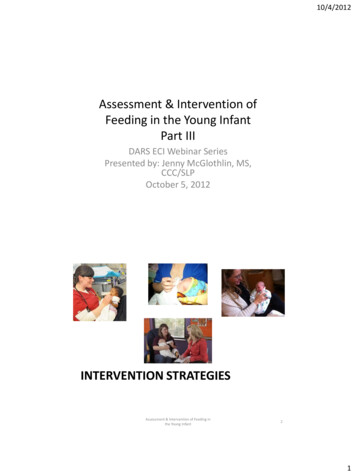
Transcription
10/4/2012Assessment & Intervention ofFeeding in the Young InfantPart IIIDARS ECI Webinar SeriesPresented by: Jenny McGlothlin, MS,CCC/SLPOctober 5, 2012INTERVENTION STRATEGIESAssessment & Intervention of Feeding inthe Young Infant21
10/4/2012Support Positive Experiences Support SKILL first!– Look to stability signs to determine readiness for andinfluence of feeding Implement feeding supports to facilitate skilldevelopment Without skill:– Repeated experiences of feeding with POOR skill may leadto avoidance behaviors and – Repeated experiences build neural pathways that supportdevelopment of POOR skills Gagging Gasping Poor vital signs (desaturation)Assessment & Intervention of Feeding inthe Young Infant3Once Skill is Developed Skill leads to efficiency during feeding Efficiency leads to endurance sufficient forfeeding full volumes and discharge Skill, efficiency, and endurance lead to abilityto eat comfortably, and to eat sufficientvolume for appropriate growthAssessment & Intervention of Feeding inthe Young Infant42
10/4/2012To review SKILLEFFICIENCYENDURANCEAssessment & Intervention of Feeding inthe Young Infant5GETTING BABY READY TO EATAssessment & Intervention of Feeding inthe Young Infant63
10/4/2012Stimulation or Experience? “Oral stimulation” is considered as aprogrammatic approach to providing tactile inputto the face/mouth/tongue/lips of an infant– Oral motor stretches (Beckman)– Any tapping, temp change, etc. that you provide “Oral experiences” refers to infant-driven positiveexperiences around face/mouth/tongue/lips– Kangaroo mother care (KMC)– Non-nutritive sucking– Independent exploration of face/mouthAssessment & Intervention of Feeding inthe Young Infant7Need to Differentiate Use is dependent upon the child’s history and needs Oral experiences have a body of research supportingthe benefits Oral stimulation programs have less research– No oral stimulation program has been conducted withoutnon-nutritive sucking, which is known to be beneficial– For preemies: Concerns regarding poor weight gain and stress during stimulationprograms (e.g., Apnea, bradycardia). No decrease in length of stay or gestational age at which full oralfeedings are achieved.Assessment & Intervention of Feeding inthe Young Infant84
10/4/2012Guidelines for Use of Oral-FacialStimulation Materials Should satisfy one or more of these purposes:– Stimulate a more active sucking pattern– Reduce hypersensitivity in the mouth– Reduce the strength of the tonic bite reflex– Increase acceptance of objects coming towardface– Increase the amount of oral experience andexploration so child will obtain better tongue, lip,and jaw movements for feeding and sound play– Increase oral organizationAssessment & Intervention of Feeding inthe Young Infant9Non-nutritive Sucking Largest body of evidence to support benefits No evidence of detrimental effects Significantly decreases the length of hospitalstay in preterm infants Supports transition from tube to bottle feeds Supports better bottle feeding performance(Harding, 2009; Pinelli & Syminton, 2005)Assessment & Intervention of Feeding inthe Young Infant105
10/4/2012Using Sensory Environment:Vestibular/MovementWays to Alert Pick up baby and rock himfrom side to side Do not use a rhythmicalmotion as it could makebaby less alert If firmly supporting baby’shead, could use up anddown motion Try prone position forfeedingWays to Calm Swaddle the baby as deeppressure provided may helphim integrate sensory input Use rhythmic vertical bouncingmovement Make sure all movement isrhythmical Some children with significantimpairments to sensorysystem may need very firmbouncing or jigglingAssessment & Intervention of Feeding inthe Young Infant11Using the Sensory Environment:Proprioceptive/TactileWays to AlertWays to Calm Present uneven or roughtextures Use light tickles or touch onpalms or soles of feet;massaging palms, soles, orcrown of head can maintainalert state Use cool washcloth on face Change clothing or diaper orunwrap baby so he is not toowarm Elicit rooting Interact with baby face to face Swaddle baby to provide calming effectas the baby feels more secureReposition baby by pulling arms andshoulders slightly forward to midlineand slightly flexing hipsPlace a small rolled-up washclothbeneath infant’s feet for him to grabwith his toes to provide additionalcalmingMake sure baby maintains flexedpositionElicit non-nutritive suckingProvide deep pressure to limbs andtrunkUse foods and liquids of more thicknessand texture if approved by thepediatricianAssessment & Intervention of Feeding inthe Young Infant126
10/4/2012Using the Sensory Environment:Temperature/Olfactory/GustatoryWays to Alert Provide very warm or verycold stimuli Use any strong or uniqueodors (e.g., perfume, loosespice tea) Offer foods with very sharptastes such as sour, bitter, saltyor sweet (keep in mind thatjarred baby foods have verylittle added salt or sugar andthus may be too blandWays to Calm Use room temperaturefoods Use subtle scents (e.g.,lavender, vanilla) Avoid food with sharp tastesAssessment & Intervention of Feeding inthe Young Infant13Using the Sensory Environment:Visual/AuditoryWays to AlertWays to Calm Use bright colors Provide shiny objects Move objects in the child’speripheral vision Make use of contrasting brightcolors or shapes Use bright lighting Talk to the baby with varyingpitch, volume, and rhythm Music may improve arousal Make unexpected or loudnoises Use neutral colorsProvide dull objectsUse dim lightingAvoid moving objectsReduce auditory input to baby(stop talking) Provide soft, repetitive sounds Use white noise to block outother sound Play music with slow tempoand regular rhythmAssessment & Intervention of Feeding inthe Young Infant147
10/4/2012Bottle Feeding Positioning and support Disorganized vs. dysfunctional sucking pattern Bottle types– Gravity flow vs. negative pressure flow Nipple types– Short cylindrical, long, “orthodontic”Birth to ThreeBottle FeedingPositioning:– Should be supportive of midline positioning of arms,legs, neck, head– Should prevent fluid from collecting in pharynx– Should encourage close contact with parent Elevated side-lying appears to be beneficial and does notincrease length of stay for preemies Elevated side-lying appears to improve oxygenation duringfeedings Elevated head-tilt position decreases apnea and bradycardiaduring feedings(Jones, 2008; Clark, 2007; Jenni, 1997)8
10/4/2012Neonatal Oral Motor Assessment Scale(NOMAS) – Marjorie Meyer Palmer, MS Defines sucking into threecategories– Normal– Disorganized– Dysfunctional Disorganized – “the lack ofrhythm of the total suckingactivity” Dysfunctional – “theinterruption of the successfulsucking activity by abnormalmovements of the tongue andjaw”Supporting Respiratory Organization Proactive VS. Reactive– REGULATION: designed to proactively provideimmature SSB pattern to infants who have burst ofsucking of 5 without breathing Facilitates infant’s burst/pause rhythm, to ensure atleast one breath every 3-5 sucks For respiratory-compromised infants, ex-preemies,infants with greater than 7 sucks in a row without abreathAssessment & Intervention of Feeding inthe Young Infant189
10/4/2012Regulation Technique Gentle shifting of infant and/or bottle (or breastocclusion) to slow or stop flow Tipping of bottle– Least prompt: Tip baby and/or bottle but leave ingrooveMild: In central tongue grooveMod: Out of central tongue grooveMax: Removal of bottle Stability of physiologic, motor and state If continue sucking, move bottle to side of mouthto release suction to change tactile inputAssessment & Intervention of Feeding inthe Young Infant19Supporting Respiratory Organization Proactive VS. Reactive– PACING: designed to reactively respond to infant’sfatigue/stress by providing pauses– Brief (1-2 minute) pauses to allow infant toreorganize– Very effective with medically compromisedinfants, especially those with respiratorycompromise– As they fatigue, they start to pant, so you give abreakAssessment & Intervention of Feeding inthe Young Infant2010
10/4/2012Bottle Considerations Criteria for an Effective Bottle– Shape of bottle supports head-positioning needsof infant– Holds appropriate amount of fluid so as notneeding to refill and disturb feeding process– Is easy and pleasing for infant to hold– Fits size and shape of feeder’s hand– Is sturdy and unbreakable– Can be colored or decorated to attract andmaintain infant’s visual attentionNipple Considerations Criteria for an Effective Nipple– Fits size and shape of infant’s mouth– Flow rate is appropriate for: Infant’s abilities Consistency of liquid being presented Infant’s feeding position**DO NOT want holes to be artificially enlarged, causing a rapid,uncontrolled flow of liquid– Provides adequate stiffness or resistance to infant’ssucking pattern. Soft nipple more appropriate forweak suck or easily fatigued Should NOT collapse when infant sucks11
10/4/2012Nipples Current options include:––––Standard NippleMead Johnson Slow Flow; Similac Slow FlowGerber slow, medium and fast flow nipplesOrthodontic nipples: NUK: regular, slow, medium, fast Similac– Cleft Palate: Mead Johnson Cleft Palate Nurser Haberman Feeder Pigeon cleft palate nippleStandard Nipple Slow-Medium flow rateSeveral researchers state thisshould be the nipple used withmost infants, and manyrecommend use of this nipplefor the first feed of all infantsDisposableMilk continues to flow whenbaby pauses12
10/4/2012Disposable Slow Flow Mead Johnson Similac– -teal ring– Slow flow– Ideal for preterminfants– -yellow ring– Slow flow– Ideal for preterminfantsOrthodontic nipples 2 types available (NUK & Ross SimilacOrthodontic) High flow rate Breastfeeding is NOT an indication to use thisnipple Require a completely different tongue and lipmotion to obtain milk-disposable-variable flow rate-good for infants with poor lip closure ordecreased lingual cupping-good for infants with “compression” suck-good for thickened feeds13
10/4/2012Gerber Slow and Medium Flow Nipples Designed to help infants who havedifficulty swallowing a largeamount of milk at one time.May be helpful for babies whohave to swallow multiple times totake care of the volume in theirmouths.ReusableDoes not flow when baby pausesGerber Fast Flow Nipple Occasionally, infants requiringthickened feeds need a fasterflow nippleReusableContinues to flow when babypauses14
10/4/2012Therapeutic TroubleshootingProblem Weak suck (overallweakness from medicalcompromise, respiratory orendurance problemsTreatment Techniques Position appropriatelyEstablish non-nutritive suckApply firm, gentle pressure to thelipsUse firm jaw and cheek supportUse small bottle so you can holdit and still provide jaw and cheeksupportOnce suck pattern is established,gently try to pull nipple frommouth to promote strongersuckingSlightly increase bolus sizeTherapeutic TroubleshootingProblemTreatment Techniques Excessive jaw movement (mayresult in abnormal tonguepattern and compromised lipseal) Caused by: Head and neck aligned or withslight flexion Provide some pressure withfinger under infant’s jaw tohelp grade movement of jaw(mandible, not base of tongue) Bring infant’s head into moreneck flexion to allow chest toprovide stability for the jaw(monitor respiration carefully)– Jaw instability, which may beresult of inappropriate tone– Premature infant notdeveloping tone in bulk in oralfacial muscles– Neck hyperextension may yieldjaw instability15
10/4/2012Therapeutic TroubleshootingProblem Weak latch/open mouth; lackof interest Caused by:–––––Poor arousalPoor hunger signalsStressLow oral-motor toneInfant trying to maintainopen airwayTreatment Techniques Arouse infant Stimulate rooting Try prone position Use lingual stroking ortapping to increase toneand facilitate forwardtongue position Use organizing techniquesTherapeutic TroubleshootingProblem Poor lip seal (reduced negativepressure for suck- hear asmacking sound when pressureis lost and may see milk leakingfrom corners) Caused by: Decreased muscletone/weakness (premature) Excessive jaw mvmts & widejaw excursions make closuredifficult Abnormal tongue mvmts withstrong protrusion push fluidout Absent or small sucking/fattypadsTreatment Techniques Provide external support tocheeks and lips to help infantclose lips around nipple Put thumb and index (ormiddle) finger on sucking padsto help infant purse lips Provide some jaw support, ifneeded Use smaller bottle so you canreach around to providesupport16
10/4/2012Therapeutic TroubleshootingProblem Poor initiation of sucking (if babyis hungry but cannot initiatesucking, becomes even fussier)Caused by:– Hyperactive root reflex may resultin rooting nipple rather than latch– Mouth wide open/unable to closeto start sucking– Ineffective tongue protrusion ormildly hypersensitive responsewhich prevents initiation– If too hungry, may have problemsinitiating sucking Crying is LATE sign of hungerTreatment Techniques Control head throughpositioning to decreaseexcessive rooting Put nipple on midline ofbaby’s tongue, applydownward pressure, andprovide cheek support If child has trouble closingmouth, assist with jawcontrolTherapeutic TroubleshootingProblem Disorganized sucking(characterized bydisorganized and unevenpattern; coughing andchoking typically noted) Factors:– General neurologicaldisorganization– Mild respiratory problems– Nipple flow rate incompatiblewith infant suckTreatment Techniques Bundle infant to decreaseextraneous mvmtReduce extraneous noise andlightUse rocking or music to help withrhythmUse gentle pacing (i.e., take bottleaway after one or to sucks andallow pause)Reduce flow rate (e.g., differentnipple, thicker liquids). Thickerliquids cause infant to suckharder and may improve timing17
10/4/2012Therapeutic TroubleshootingProblem Fatigue or lethargy duringfeeding (often a reflectionof an infant having to worktoo hard to breathe andeat)– Caused by: Poor coordination ofbreathing and eatingTreatment Techniques Provide smaller amounts bymouth and increase gavage(tube) feeding Provide non-nutritivesuck/oral stimulation duringgavage feeding Reduce distractions inenvironmentSPECIAL POPULATIONS:PREEMIES18
10/4/2012Premature InfantvsHealthy Term Infant Premature Infant– Immature suck, swallow,breathe pattern– Behavioral states are not welldefined– Auditory, tactile, vestibular,and visual systems are not fullydeveloped Term Infant– Coordinated and consistentsuck, swallow, breathe pattern– Behavioral states generallywell-defined, with cleartransitions– Auditory, tactile, vestibular,and visual systems are morematureAt risk continued Preterm – commonly have problems with fatigue, suck/swallow/breathecoordinationGastrointestinal issues (gastroesophageal reflux, tracheo-esophagealfistula, esophageal atresia) - delayed gastric emptying, poor motilityProlonged intubation/suctioning (medically fragile, chronically ill, onECMO) - prone to aversionSpecific syndromes that will affect neurological status, facial anatomy,etc 19
10/4/2012Feeding: An Interactive Process Promote a positive environment for feedingsObserve for signs of readiness for nipplingObserve for signs of stress during feedingsEducate families and others about providing a positive feedingexperience for babiesPromotion of an Ideal Feeding Start with one feeding per dayQuality versus quantity feedsFeed infant in a quiet alert stateMaintain postural control with midline orientation and good head/neckcontrolPromote a positive oral sensory experiencePause when the infant is showing stress signs and stop the nippling ifstress signs persistAt the end of the feeding, ask yourself –Was the feeding safe? Was the feeding pleasurable?Choice of nipple for each baby should be based on baby’s abilities, andmedical needs, not gestation or breast vs. bottle.20
10/4/2012Readiness Cues from Baby At least 34 weeks adjusted gestational ageIn quiet alert state for at least 5 minutesShows “hunger cues”–––––– Shows signs of physiologic stability such as:––– Hands to mouthSmackingTongue thrustingRootingNon-nutritive sucking during gavage feedsCrying (late hunger cue)Smooth and regular respiratory rateStable heart rateSuccessfully demonstrates self regulatorybehaviorsWakes before feeding timeDemonstrates a sustained, rhythmical nonnutritive suckCommon Stress Signs––––––––––––Burping excessivelyAudible swallowsSpitting up consistentlyArching/posturing of trunk or extremitiesChange in vital signsChange in color – even a mild change issignificantHiccupsYawningPantingTurning/Pulling awayChange in stateGaze Aversion GrimacingWorried lookHyperalertMottlingPaleCoughingPursing lipsTongue blockingDuskyGaggingChokingLoss of coordination suck/swallow/breatheSneezingCessation of sucking21
10/4/2012Promotion of an Ideal Feeding Start with one feeding per dayQuality versus quantity feedsFeed infant in a quiet alert stateMaintain postural control with midline orientation and good head/neckcontrolPromote a positive oral sensory experiencePause when the infant is showing stress signs and stop the nippling ifstress signs persistAt the end of the feeding, ask yourself –Was the feeding safe? Was the feeding pleasurable?Choice of nipple for each baby should be based on baby’s abilities, andmedical needs, not gestation or breast vs. bottle.Common Myths All babies with reflux throw upIf they take a pacifier theyshould also be able to take abottleChin/Cheek support will teach ababy to suckTwisting the nipple, pulling thenipple in and out, and “milking”the bottle are appropriate waysto help the baby get his/herminimum feed22
10/4/2012What You Can Do Remember the causes we have influence over –environment andcaregiving practicesALWAYS watch for stress cuesSTOP if you see stress cuesIf these signs are noted, patient is not handling the feeding well –––––––––––Burping excessivelyAudible swallowsSpitting up consistentlyArching/posturing of trunk or extremitiesChange in vital signsChange in color – even a mild change is significantHiccupsYawningPantingSquirming or increased activityChange in stateDo’s and Don’ts Do:–––––––SwaddleHold in cradle position at appropriateangle while providing needed supportSupport head so that head and neck arein alignmentFollow ordersWatch baby for signs of stressGavage feed remaining feed if babyshows signs of stress without takingminimumProvide chin/cheek support to improvelip seal/cheek stability and feedingperformance once they are suckingDon’t–––––––Force feed to reach a minimumFeed baby propped up in bedFeed without head and neck alignedPlace baby flat on lap to feedCup feed SGA or premature babiesProvide chin/cheek support to “teach”a baby to suckTwist nipple, pull nipple in and out, or“milk” the bottle23
10/4/2012SPECIAL POPULATIONS:TUBE-FED INFANTSOur Role Educate parents about tube feeding Prevent problems from developing Optimize oral motor control and oralenjoyment for exploration and feeding24
10/4/2012Therapist Roles Education– Resource for family about tube feeding– Assist to prevent problems Ongoing Consultation– To monitor progress of feeding by tube and monitor development of oral skills– Recommend more specific oral treatment as needed Family Support– Offer opportunities for families to come together with other families to share experiences– If possible, set family up with a “mentor” family Direct Oral Treatment– Treat oral sensorimotor difficulties, which may involve using food– Goals may include: improving feeding relationshipoptimizing feeding enjoymentoral normalization and desensitizationexperimentation with new food and texturesIncreasing pleasure in increased quantities of foodGavage Feeding Bolus versus Pump NG, OG, G-tube, G-J tube Encourage non-nutritivesucking during gavagefeeds using soothiepacifier Hold patient swaddled aspatient would be held forbottle feeding25
10/4/2012Positioning for Feeding Provide tube-fed child with physical andemotional nourishment that oral feeders receiveat mealtime– If age appropriate, hold baby while tube-feeding Closeness important for attachment and bonding– Give pacifier to facilitate non-nutritive sucking whilebecoming full– If sleeping while being fed, best position is elevatedprone with a sling support or in sidelying position onright side to facilitate more rapid stomach emptyingTreatment Comprehensive Oral Motor Treatment– Focus strongly on parent-child interaction during mealsand education– Develop positive and enjoyable use of the mouth in all itsfunctions– Focus is on developing appropriate use of mouth inconjunction with respiratory and phonatory systems, inexploration, sound play, and as much oral feeding aspossible– Food and liquid are NOT essential and may not be includedat all if child has a severe swallowing disorder May be introduced to provide smells, tastes, and temperatures,and to elicit specific oral movements when child is able to handle26
10/4/2012Treatment, cont.– Strategies include opportunities for development ofsensory awareness, perception, and discriminationwithin the mouth– Oral feeding is the by-product of a total program, notthe major goal– Provides support for child and family: Looks at themouth as part of a whole child, who is part of a wholefamily– Child develops skills from their own starting point onthe continuum, and THEY set the pace (medical status,growth, dev. of oral skills)Considerations As baby gets closer to 6 months (dev. age),consider rotating formulas with differentnutritional components or use of homemadeblended formula to establish HomemadeBlendedFormulaHandbook.htm27
10/4/2012Outcomes Children who are dependent on tube feedingsare at a higher risk of developing a feedingdisorder than their healthier counterparts(Newman, 2000; Ross & Browne, 2002) At risk for oral aversions, oral hypersensitivity,and disassociating oral-motor movementswith satiation of hunger. This makes reinitiation of feeding by mouth difficult andtime intensive (Gosa & McMillan, 2006)SPECIAL POPULATIONS:DOWN SYNDROME28
10/4/2012Incidence & Possible Medical Issues Estimated incidence is between 1 in 1,000 to 1 in1,100 live births worldwide Each year approximately 3,000 to 5,000 childrenare born with this chromosome disorder and it isbelieved there are about 250,000 families in theUnited States of America who are affected byDown Syndrome. Hearing deficits, congenital heart disease,intestinal abnormalities, eye problems,immunologic concernsSpecific Considerations Low tone– Low tone Weakness– Tongue: reduces strength & skill for movement, shape may be thick andhumped, bolus collection inefficient– Cheeks: reduces strength & skill for lip and cheek movement, lack control &flexibility for efficient sucking, liquid/food falls into buccal cavity, can causemouth to hang open Oral control issues– Jaw instability and tongue protrusion Tongue protrusion limits mobility and freedom of tongue to assist in eating/drinkingMay influence the development of mature swallowing pattern because protrusion pattern is incompatible withtongue-tip elevationSensory Issues– Decreases in postural tone can raise sensory threshold to all stimulation soability to perceive small amts of sensory information may be reduced– Treatment should focus on changing aspects of overall physical environmentwith physical handling and positioning to increase postural tone andresponsiveness to sensory input29
10/4/2012Treatment Strategies Facilitating normal suckling pattern– Suckle pattern weak, disorganized, poorly sustained– Consider cardiac impact on respiration/endurance– Reduce impact of limiting physical patterns(extension/decreased postural tone) through positioningand handling– Facilitate flexion with chin-tuck position to increasesucking skill– Use non-nutritive sucking to stimulate stronger suck byusing traction– Timing issues - focus on developing a suckle pattern thatis easily initiated, rhythmical, strong, sustained andefficient (pacing/regulation/external support)SPECIAL POPULATIONS:CLEFT LIP & PALATE30
10/4/2012Considerations Cleft lip alone or isolated cleft of soft palate haveless trouble with feeding– Cleft lip only CAN breastfeed– Seal can be created by positioning cleft next to breastor by use of mother’s thumb to take up space Degree of difficulty feeding strongly correlatedwith degree and location of clefting Consider grieving process of family with arrival ofa different baby Focus on feeding interactions and give support asneededChoice of Feeding System for CleftPalate Important factors to consider––––––––––Provide as normal a mother-infant interaction as possible?Give baby control of liquid flow rate?Work on a positive pressure compression system?Does nipple compress easily?Is flow rate rapid enough without being too fast?Is nipple soft to reduce unnecessary fatigue?Is it readily available?Is it affordable?Is it safe?Can it be easily cleaned?31
10/4/2012Always: Feed in a more upright position– Allows gravity to move liquid into pharynx whiledirecting it away from nasal cavity, ears, and cleft Feeding should be slow enough to preventchoking, coughing and loss of liquid into nasalcavity, but fast enough to prevent fatigue Burp frequently– Much more air swallowed during feeding w/ cleft Consider feeding infant smaller amounts of liquidat each feeding and increasing number per dayCleft palate nurser Designed for use with babies with a cleftpalate who are unable to create an effectiveseal for a successful suckSqueeze gently as infant sucks, stop when hestops.Some of these infants can successfully nurseeven though unable to take a regular bottleCan be used with standard term nippleAllows for infant to extract milk usingcompressionMade of soft plastic that is easy to squeeze inorder to assist infant with milk extractionFeeder is in charge of flow rateReusablePrice approximately 16 for 6 bottles32
10/4/2012Haberman feeder Designed by the mother of a child withneurological problemsLength of line on the nipple pointed towardinfant’s nose controls flow of formulaFormula should always be in the nippleAllows for infant to use compression(positive pressure) of lips and gums to getmilkAllows for feeder to assist with milkextractionHas 3 flow rates: slow, medium, fastHas 1-way valve to prevent backflowFeeder is in charge of flow rateReusablePrice approximately 22.50 per bottlePigeon Cleft Palate Nipple Y cut nipple with thin and thick sideHas a 1-way valve to help preventexcessive air intake and backflowAllows for infant to extract milk usingcompressionFlow rate controlled by infant onlyDoes not allow help from feederSoft bottle available to order if infantneeds help from feederPrice approximately 3.50 per nipple33
10/4/2012QUESTIONS?Additional ReferencesClark, L., Kennedy, G., Pring, T., & Hird, M. (2007). Improving bottle feeding in preterm infants:Investigating the elevated side-lying position. Infant, 3(4), 154-158.Gosa, M & McMillan, L. (2006). Therapeutic Considerations for Children and Infants with Feeding Tubes.Division 13 Newsletter. October 2006.Harding, C. (2009, August). An evaluation of the benefits of non-nutritive sucking forpremature infants as described in the literature. Arch Dis Child, 94(8), 636-640.Jenni, O. G., von Siebenthal, K., Wolf, M., Keel, M., Duc, G., & Bucher, H. U. (1997). Effect of nursing inthe head elevated position (15 degrees) on the incidence of bradycardic and hypoxemicepisodes in preterm infants. Pediatrics, 100(4), 622-625.Jones, K. (2008). The effect of positioning on the transition from tube to oral feeding in preterm infants:A pilot study. Arch Dis Child Fetal Neonatal Ed, 93(1), Fa80. Newman, L.A. 2000. Optimal care patterns in pediatric patientswith dysphagia. Seminars in Speech & Language, 21, 281-291.Pinelli, J., & Symington, A. (2005). Non-nutritive sucking for promoting physiologic stability and nutritionin preterm infants. Cochran Database Syst Rev, (4), CD001071.Reilly, S., Skuse, D., Wolke, D., & Stevenson, J. (1999). Oral-motor dysfunction in chidlren who fail tothrive: organic or non-organic. Developmental Medicine & Child Neurology, 1, 115-122.Ross, E.S. & Brown, J.V. 2002. Developmental progression of feeding skills: An approach to supportingfeeding in preterm infants. Seminars in Neonatology, 7, 469-475.34
**DO NOT want holes to be artificially enlarged, causing a rapid, uncontrolled flow of liquid -Provides adequate stiffness or resistance to infant's sucking pattern. Soft nipple more appropriate for weak suck or easily fatigued Should NOT collapse when infant sucks . 10/4/2012 12
